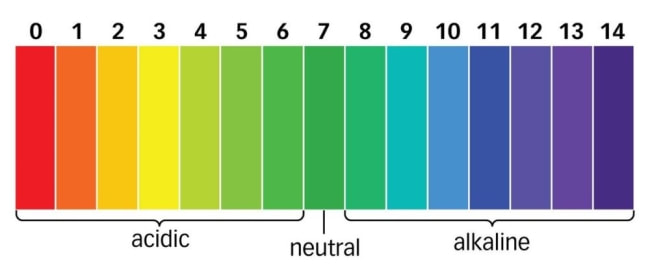What is pH?
How does the pH affect the cleaning power and corrosiveness of a product? pH (Potential Hydrogen)
| ph-scale.pdf |
A measure of the degree of the acidity or the alkalinity of a solution as measured on a scale (pH scale) of 0 to 14. The midpoint of 7.0 on the pH scale represents neutrality, i.e., a "neutral" solution is neither acid nor alkaline. Numbers below 7.0 indicate acidity; numbers greater than 7.0 indicate alkalinity. It is important to understand that pH is a measure of intensity, and not capacity; i.e., pH indicates the intensity of alkalinity in the same way temperature tells how hot something is, but not how much heat the substance carries.
The pH scale is logarithmic which means that moving on (unit either way on the pH scale results in a 10 fold increase in the degree of alkalinity or acidity.
Some typical pH values are included in the following table
As a general rule of thumb, cleaning performance on typical oily soils is enhanced with an increase in pH. Some soils, for example hard water deposits, are best removed with acids.
The pH scale is logarithmic which means that moving on (unit either way on the pH scale results in a 10 fold increase in the degree of alkalinity or acidity.
Some typical pH values are included in the following table
As a general rule of thumb, cleaning performance on typical oily soils is enhanced with an increase in pH. Some soils, for example hard water deposits, are best removed with acids.
Classification, pH, Product
Acidic
0-1 Hydrochloric, Sulfuric, Nitric Acids
1-2 Phosphoric, Sulfamic Acids
2.0 Citrus Fruit
6.0 Milk
Neutral
7.0-7.5 Water, Sugar, Table Salt
Alkaline
8.0 Eggs
11.0 Ammonia
13-14 Caustic Soda, Degreasers
0-1 Hydrochloric, Sulfuric, Nitric Acids
1-2 Phosphoric, Sulfamic Acids
2.0 Citrus Fruit
6.0 Milk
Neutral
7.0-7.5 Water, Sugar, Table Salt
Alkaline
8.0 Eggs
11.0 Ammonia
13-14 Caustic Soda, Degreasers
Products at the two extremes (less than pH 1 or greater than pH 13) are extremely oppressive and corrosive. Examples include, sulfuric and hydrochloric acid on the acid end, and caustic soda on the alkaline end. Use solutions of phosphoric or sulfamic acid cleaners, typically in the pH range of slightly less than 2, may be described as "safe" acids comparison to the stronger acids. Of course, necessary safety precautions (eye and hand protection) as noted on the Material Safety Data Sheet should always be followed.
As an illustration of their non-aggressive behavior in comparison to stronger acids, products containing sulfamic or phosphoric acid were found to result in no chemical attacks on nylon carpets. On the other hand, a hydrochloric or powder acid-based product would basically dissolve the fibers.
Other than the two pH extremes, the pH scale becomes secondary to the inherent properties of the specific chemical in terms of corrosiveness. As an example, the pH of carbonated cola soda (which contains phosphoric acid) is in the 2.5 range. A concentrated (35%) hydrogen peroxide solution has a pH of approximately 3.5. Carbonated cola soda may be slightly irritating to the eyes, causing no permanent damage. However, a 35% hydrogen peroxide solution will cause chemical burns to the skin or mucous membranes. Thus, it is not the pH factor alone that causes corrosion of products to surfaces.
As an illustration of their non-aggressive behavior in comparison to stronger acids, products containing sulfamic or phosphoric acid were found to result in no chemical attacks on nylon carpets. On the other hand, a hydrochloric or powder acid-based product would basically dissolve the fibers.
Other than the two pH extremes, the pH scale becomes secondary to the inherent properties of the specific chemical in terms of corrosiveness. As an example, the pH of carbonated cola soda (which contains phosphoric acid) is in the 2.5 range. A concentrated (35%) hydrogen peroxide solution has a pH of approximately 3.5. Carbonated cola soda may be slightly irritating to the eyes, causing no permanent damage. However, a 35% hydrogen peroxide solution will cause chemical burns to the skin or mucous membranes. Thus, it is not the pH factor alone that causes corrosion of products to surfaces.

